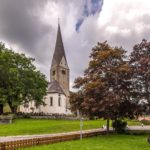Architecture | Cultural offerings
A typical Walser house in Bödmen
-
This house was originally built as a single room house in 1552, and was enlarged in 1557. Just as with all Walser houses, its gabled front looks out over the valley axis. Also typical for this form of house in the valley is the entrance way, the so-called “Brügge”, facing the sun. This consists of open room, covered over by a balcony and closed in on two sides by the house walls. This wooden podium, a place to relax and rest, is a cozy arrangement which is found only in the Walser Valley, and has a folding table and bench at the wall. One special feature is the roof covered with stone shingles – the “Schwoardach”. In its third enlargement phase in 1602 a second cellar, small rooms below and above, and a cellar under the kitchen, were added.
In the fourth construction phase of 1694 the house was given its present form by adding on a “Roschtel” (horse stables), a pantry and a wood shed. The Roschtel reminds us of the Walsers’ intensive use of horses in the 18th century for tranporting goods. They used horses to transport important merchandise such as salt, wine, silk, jewelry items, tools, dairy products, etc. over Tyrol to Italy. In 1708 116 horses were registered in the valley. With the finishing of the construction of the Arlberg Railway in 1884 this era came to an end. On the cellar walls, which jut out about 20 centimeters, the solidly built timber construction rests entirely on axe-hewn spruce logs, everything held together with hardwood dowels. In the 17th century the house was provided with a chimney and oven. This stone oven, covered with clay, was replaced in 1950 with a tiled oven. On the ground floor there is the living room (5.7 m2), the chamber (bedroom) and the kitchen, as well as a sidewards addition which used to be the horse stables and is now a workshop.
The wall and ceiling paneling in the living room date from the 17th century, the home or family altar and the living room doors are painted in the Baroque style of the 18th century. The kitchen, added in the 17th century, had an open fireplace until 1938. The smoke vault was used up until about 80 years ago to smoke and cure meat. It is located, as in all Walser houses, on the north, shady side, while the living room was built in the southwest corner. The room height is about 1.95 meters. In the story above there are the upper living room, the upper chamber, a corridor with fireplace and, in the back part of the house, a small chamber (formerly a food pantry). In the corridor of the upper floor there is a cabinet painted with ox blood (16th century). The attic is called the “Chatzadiile” here. In the gable area of the house hangs a Nazarene style crucifix. The small double windows (49 x 62 centimeters) have cross-bars and are provided with sliding sections. Only the chamber has a large window, which is protected with an iron grating, the “Gräms”. In a few Walser houses there is still a “plague hole” between “Brüüge” and living room window. The plague victims of the 17th century were provided here with food and drink from the outside, until the black death came to take them off.
This farmhouse also has a stables building on the side facing the mountain. In accordance with the Walser type of housing it lies a stone’s throw from the house. This regulation follows the Burgundian custom, and not the Alemannic one, where people, domestic animals and feed are kept together under one roof.
Presented by: Kleinwalsertal Tourismus eGen
Author: Kleinwalsertal Tourismus eGen -
Approach:
Route Planner -







